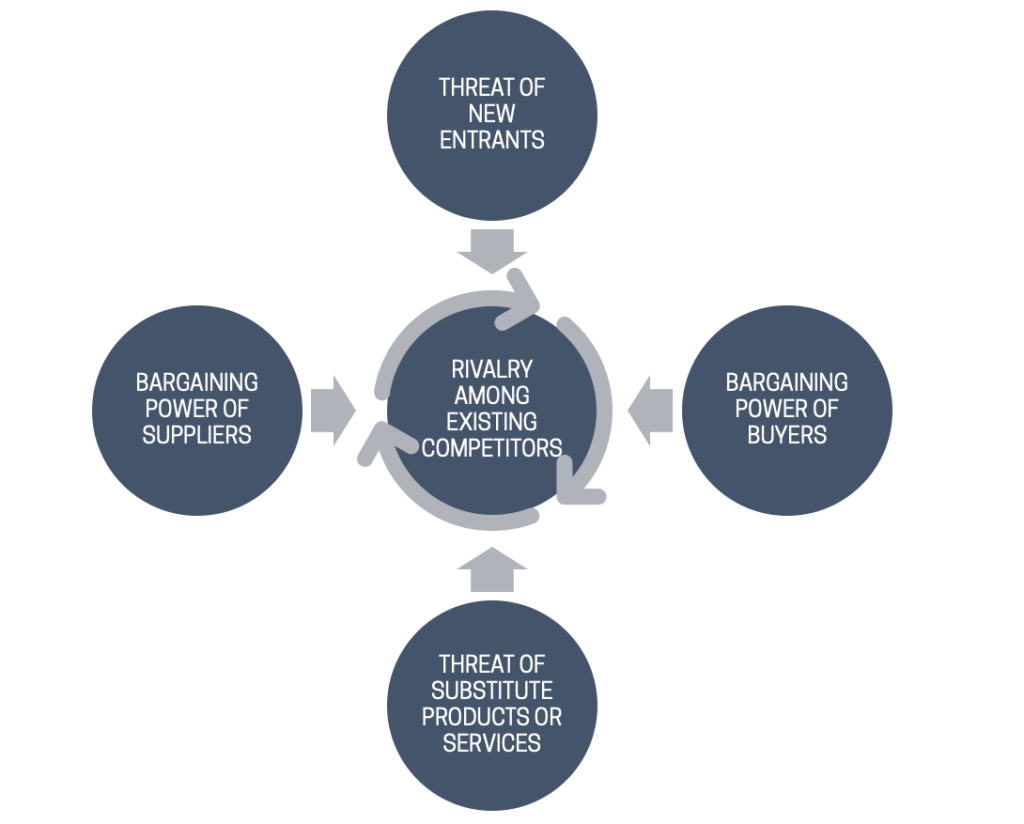How can Porter’s Five Forces be asked in the CIPS exam?
Based on my experience and insights shared by other CIPS candidates, Porter’s Five Forces are frequently featured in CIPS Level 4 exams. The questions typically focus on the characteristics of the five forces: threat of new entrants, bargaining power of buyers, bargaining power of suppliers, threat of substitutes, and competitive rivalry.
To effectively tackle exam questions on Porter’s Five Forces, you need a deep understanding of the model. As mentioned in previous posts, using exploratory questions like “What?”, “Why?”, and “How?” can help you explore the topic in depth.
Porter’s Five Forces are designed to help you analyze the market in which you source goods for your organization. The deeper your market understanding, the better your purchasing decisions will be. The model outlines the market structure and how different players interact within it.

In the picture, you can see that threat of new entrants, bargaining power of buyers, threat of substitutes and bargaining power of suppliers are four market forces which decide the level of competition in the market.
Threat of new entrants: It refers to how easy or difficult it is for new companies to join the market. If the barriers are high, the number of new entrants is low. For example, you want to join a car market as a provider. This decision requires a very high initial investment on factories, machines, equipments and labors. Affordability becomes a significant barrier. Furthermore, there are some established manufactuers in the market who are well-known for their price, service and quality. The consumers may not be willing to switch to a new car seller, as they have to incur loss of value. Both factors will hinder your ability to attract customers. CIPS may ask you about the charactertistics of threat of new entrants. You may be presented with a scenario involving high investment or high switching costs and you are required to identify which market force is being described.
Bargaining power of suppliers: When the market has a few suppliers capable of producing a particular item, they become dominant in the market and they have a high bargaining power. This phenomenon can be seen in the market of specialized or unique items. Some suppliers even acquire their own distributors, so they can control directly their distribution channels. In this case, if you are just a small customer, you may struggle to negotiate a discounted price with such suppliers. Conversely, the bargaining power of supplier is low if many providers provide standardized items.
Bargaining power of buyers: Well, when you search the market, you realize that there are many suppliers who can satisfy your demand. Absolutely, you hold a strong bargaining power and you can easily negotiate a high discount for your purchases. Besides, if switching suppliers incur little to no cost, you can simply select the supplier offering the best deal. Many buying organizations acquire their own providers, allowing them to directly control quality and cost. This is known as backward integration.
In the exam, CIPS may ask you to identify which power is more likely in a given market and what factors lead to high bargaining power for suppliers/ buyers. For example, the exam question describes a scenario in which 50 suppliers can fulfil a buyer’s demand. The correct choice would clearly be barganing power of buyer.
Theat of substitues: It refers to the availability for alternative products that can fulfil customer’s demand. If buyers have many options offering advantages in term of cost or quality, the buyer has more power to deal with the supplier. A wide range of substitues force suppliers to compete for customers, which limits their pricing power.
Rivalry among existing competitors: It refers to the intensity of competition between players in the market. High rivalry indicates many providers, similar products and low profitability. Suppliers compete with each other to gain market share and they are forced to reduce their price to attract more customers. This phenomenon is called as price war. In such case, the buyer can benefit from high rivalry. In the part, CIPS may ask you to identify the characteristics of market with high or low rivalry among competitors.
We provide CIPS practice questions with answers and detailed explanation, besides they are updated regularly to reflect the actual exam. If you want to consolidate your knowledge before the exam, you can check the links below. The discount code is JULYEXAM25.
L4M1: https://www.udemy.com/course/cips-l4m1-practice-test-short-learning-guide/?couponCode=MASTEREXAM25
L4M2: https://www.udemy.com/course/cips-diploma-l4m2-practice-test/?couponCode=JULYEXAM25
L4M5: https://www.udemy.com/course/cips-practice-test-commercial-negotiation/?couponCode=JULYEXAM25
L4M7: https://www.udemy.com/course/level-4-diploma-whole-life-asset-management-l4m7/?couponCode=JULYEXAM25
L4M8: https://www.udemy.com/course/cips-l4m8-practice-in-procurement-and-supply/?couponCode=MASTEREXAM25
L5M2: https://www.udemy.com/course/cips-l5m2-daniel-do/?couponCode=JULYEXAM25
L5M3: https://www.udemy.com/course/l5m3-daniel/?couponCode=JULYEXAM25
L5M4: https://www.udemy.com/course/l5m4-advanced-contract-and-finance/?couponCode=MASTEREXAM25
L5M5: https://www.udemy.com/course/l5m5-daniel/?couponCode=JULYEXAM25